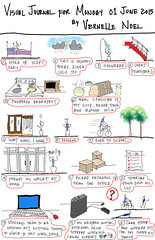This is the second day of my dedication to Trinidadian architect Colin Laird, for his contribution to the art of architecture, the profession of architecture, and to the Caribbean’s built environment. Above is a drawing of The Lion House in Chaguanas, Trinidad done by him. In April 1991 Surendranath Capildeo retained the services of Colin Laird Associates to advise on and supervise the restoration of the Lion House. The Lion House stands today because of the dedicated work of Architect Colin Laird and Restorer Glen Espinet.
This internationally famous house, one of the most important heritage buildings in Trinidad, reflects North Indian architecture as remembered and self-built, down to the clay bricks, by Baba. It has since been immortalized as the Hanuman House in Vidya Naipaul’s “House for Mr. Biswas.” The house on Main Street, Chaguanas, the ancestral home of the Capildeo family, was restored by Suren Capildeo, Naipaul’s cousin. The house is also preserved in paint by artist, Adrian Camps-Campin. “Among the tumbledown timber-and-corrugated iron buildings in the High Street at Arwacas, Hanuman House looked like an alien white fortress,” Naipaul wrote. The house was built by Naipaul’s maternal grandfather, Pundit Capildeo, who arrived in Trinidad, aged 21, as an indentured labourer on board the Hereford in 1894. He came from Gorakhpur in Uttar Pradesh, India and his destination was Woodford Lodge estate, Chaguanas.
Within months of his arrival, it was arranged that he should marry the Trinidad-born Soogee Gobin, whose family was well established in the area. The Gobins, who owned a shop, paid off Capildeo’s bond and as a wedding gift they gave the young couple the land on which the Lion House stands. Soogee ran a store there while her husband carried out his priestly duties, and in 1923 they began to build the Lion House. Built in the north Indian style, the trapezoid-shaped house is unique in local architecture. It has walls almost a foot thick, and Pundit Capildeo is said to have made with his own hands all the bricks used in its construction. The house contains lot of decorative plasterwork, with figures and patterns embossed on or etched into the walls, and several rooms feature mirror work.
The store occupied the ground floor of the four-storey building, and the family lived above it. The third floor is taken up by a prayer room, and from the flat roof there is a panoramic view of the canefields of the Caroni plains and the hills of he Central Range. The lions that gave the house its name stand at each end of the wall around the first-floor gallery. Vidya Naipaul was born here in 1932 to Pundit Capildeo’s daughter Droapatie and her husband Seepersad Naipaul, but he never knew his grandfather. Pundit Capildeo died in 1926 while on his fourth visit to India. His widow, Soogee, became the head of the family. A strong-minded woman, she had over-ruled her husband’s reluctance to send their children to school, which he regarded as a corrupting Christianising influence. Thanks to Soogee, even the girls attended school and learned to speak, read and write English.
Soogee bought properties in Woodbrook and travelled to Port of Spain every week to take care of her son, Rudranath, who was to become a university lecturer and politician, while he attended Queen’s Royal College. It was for the sake of access to better schools that in 1940 Soogee moved the whole family to Port of Spain. After that, the Lion House was rented out or stood vacant, and fell into disrepair. When eventually it was renovated, it was with no respect for its original style and structure. In 1998, however Suren Capildeo, the son of Soogee and Pundit Capildeo’s son, Simbhoonath, has repainted it white and restored the grandeur of the Lion House, which stands as a monument to the indentured Indian labourers.
Sources: http://www.nalis.gov.tt
Abstract Architecture of the day:

This work byVernelle Noel is licensed under a Creative Commons Attribution-NonCommercial-NoDerivs 3.0 Unported License.










